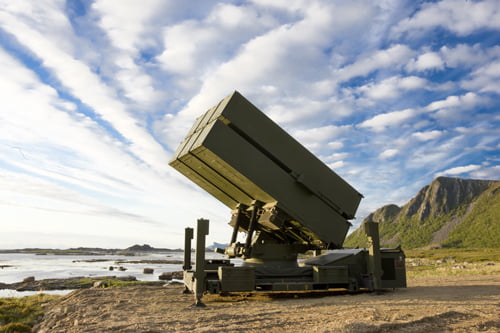A key dynamic associated with the strategic shift to higher intensity operations is working airbase defense as well as mobile basing options.
With regard to Norway, the new main operating base for F-35s will be at Orland Air Station in central Norway.
The Norwegians, along with the US and the partners, are building new 21st century air bases to operate the F-35s but are doing so driven not just by the coming of a new combat aircraft, but to meet the needs of evolving high tempo and high intensity conflict operations as well.
One aspect of building defense in depth for this base as well as for a distributed force is the Norwegian system worked with Raytheon which is called NASAMS.
Norway has built out its missile capabilities with this missile system as well as its new Joint Strike Missile which will be launched from F-35s, ships and land forces as well.
According to Kongsberg, the NASAMS system is described as follows:
Characteristics:
- Open architecture provides growth potential
- Single and multiple engagement capability
- Unpresedented fire capability
- Beyond visual range capability with active seeker missile
- Strategic and high mobility
- Low manpower requirements
- Network Centric Warfare principles of operation
- High survivability against electronic countermeasures
- Look down / shoot down capability
- High value asset defense, area and army defense, vital point and air base defense
Unlike many international air defense systems either in use or in development, NASAMS is truly a netted and distributed system.
Integration of sensors and effectors
The proven, fielded, reliable and highly capable NASAMS system contains a BMC4I (Battle Management, Command, Control, Computers, Communications, and Intelligence) Air Defense capability through the integration of sensors and launchers. It employs the Advanced Medium Range Air-to-Air Missile (AIM-120) as the primary weapon. Targets are detected and tracked by a high-resolution, 3D pencil beam radar. Multiple of these radars and the associated Fire Distribution Centres (FDCs) are netted together via radio data links, creating a real-time recognized air picture.
NASAMS can fire on target data provided by external sensors. Advanced emission control features of the radars minimize the risk of revealing the NASAMS unit’s own position. The FDC automatically performs track correlation, identification, jam strobe triangulation, threat evaluation and weapon assignment. The AMRAAM missiles used within NASAMS are identical to those used on fighter aircraft, yielding considerable rationalization returns for the user.
NASAMS in operation
The Royal Norwegian Air Force (RNoAF) was the first customer to introduce the NASAMS (Norwegian Advanced Surface-to-Air Missile System) program. Because of their success during NATO live flying exercises, NASAMS batteries are taken extremely serious by NATO aircrew. From 2004, NASAMS is earmarked by the Norwegian armed forces to be deployed in support of international crisis management operations.
NASAMS is under continuous development and every new program is adapted to the latest available technology. Currently, NASAMS is in use in 6 different nations.
NASAMS_September 2015_Screen_Small
A deployment of NASAMS to Finnmark is shown in the video below.
Finnmark is a county in the extreme northeastern part of Norway. By land, it borders Troms county to the west, Finland (Lapland region) to the south, and Russia (Murmansk Oblast) to the east, and by water, the Norwegian Sea (Atlantic Ocean) to the northwest, and the Barents Sea (Arctic Ocean) to the north and northeast.


